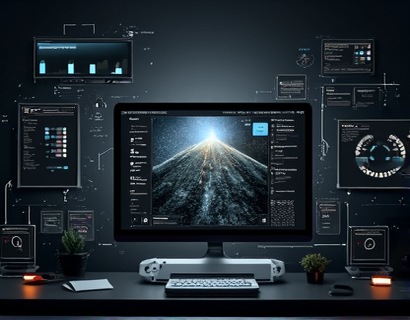AI-Powered Stadium Community: Transforming Fan Engagement with Advanced Chat Interfaces
The world of sports has always been about more than just the game itself. It's about the community, the shared experiences, and the connections formed between fans, players, and the stadiums where it all happens. In recent years, technology has played an increasingly significant role in enhancing these experiences, particularly through the integration of Artificial Intelligence (AI) in creating more interactive and personalized environments. One such innovation is the development of AI-powered chat interfaces designed specifically for stadium enthusiasts, players, and fans. This article delves into how these specialized chat interfaces are revolutionizing fan engagement and community building within the sports sector.
Understanding the Need for Enhanced Fan Engagement
The traditional stadium experience, while exhilarating, often leaves room for improvement in terms of fan interaction and community building. Fans desire deeper connections with the teams they support, other like-minded individuals, and even the players themselves. The challenge lies in creating a platform that can cater to these diverse needs effectively. This is where AI-powered chat interfaces come into play, offering a solution that combines the personal touch of human interaction with the vast capabilities of artificial intelligence.
How AI Chat Interfaces Work
At the core of these innovative platforms is AI technology that can understand, process, and respond to human language in real-time. These chat interfaces are designed to learn from interactions, improving their responses and personalization over time. Users can engage in conversations about everything from game strategies and player statistics to sharing personal stories and memories related to their favorite teams. The AI's ability to analyze user preferences and behavior allows it to tailor the conversation, providing content and insights that are most relevant to each individual.
Personalized Conversations and Insights
One of the most compelling features of AI-powered chat interfaces is their ability to offer personalized conversations. Imagine logging into the platform and being greeted with a summary of your favorite team's recent performance, complete with highlights and analysis tailored to your interests. The AI can recommend articles, videos, and podcasts based on your viewing and engagement history, ensuring that you always have access to the content that matters most to you. For fans who are also players or aspiring athletes, the platform can provide training tips, injury prevention advice, and even connect them with coaches and trainers for personalized guidance.
Exclusive Resources and Community Features
Beyond personalized content, these chat interfaces serve as a hub for exclusive resources and community features. Users can access behind-the-scenes content, such as interviews with players, exclusive footage from practices, and insider information on upcoming games. The platform also facilitates connections between fans, allowing them to form groups based on shared interests, attend meetups, and participate in discussions. This sense of community is crucial for enhancing the overall stadium experience, making fans feel more connected to the team and to each other.
Enhancing the Stadium Experience
The integration of AI chat interfaces into the stadium environment can significantly elevate the fan experience. Before the game, fans can use the platform to ask questions, get real-time updates, and even purchase tickets or merchandise with ease. During the game, the chat can provide live commentary, interactive polls, and real-time statistics, keeping fans engaged and informed. Post-game, the platform can serve as a space for fans to discuss the match, share their thoughts, and look forward to the next game. This continuous engagement helps to build a loyal and active community around the team.
Benefits for Players and Teams
While the primary focus is on enhancing fan engagement, AI chat interfaces also offer valuable benefits for players and teams. Teams can use these platforms to communicate directly with fans, share official announcements, and gather feedback. Players can use the chat to connect with fans, share personal stories, and build a stronger rapport. This direct line of communication can help in managing fan expectations, addressing concerns, and fostering a positive relationship between the team and its supporters.
Case Studies and Success Stories
Several sports organizations have already begun to implement AI-powered chat interfaces with remarkable success. For instance, a major league baseball team introduced a chatbot that provides fans with real-time updates, answers frequently asked questions, and offers personalized game day recommendations. The result was a significant increase in fan engagement, with a notable rise in social media interactions and a more active fan base. Another football club used the platform to create fan groups based on geographic locations, leading to more organized and frequent meetups, thereby strengthening the community around the club.
Technical Considerations and Implementation
Implementing an AI-powered chat interface requires careful planning and execution. The first step is to define the platform's goals and target audience. Understanding the specific needs and preferences of stadium enthusiasts, players, and fans is crucial for designing an effective chat experience. The technical infrastructure must support natural language processing (NLP), machine learning algorithms, and a robust database to store and manage user data and interactions. Ensuring privacy and security is also paramount, as sensitive information may be shared through the chat.
Future Trends and Innovations
The future of AI-powered chat interfaces in the sports industry is promising, with several trends and innovations on the horizon. One such trend is the integration of augmented reality (AR) and virtual reality (VR) to create immersive experiences. Fans could use the chat interface to interact with virtual environments, participate in AR games, or even attend virtual meet-and-greets with players. Another area of development is the use of sentiment analysis to gauge fan emotions and tailor the chat experience accordingly. This could involve adjusting the tone and content of responses to better match the user's mood, creating a more empathetic and engaging interaction.
Conclusion
The integration of AI-powered chat interfaces into the stadium experience represents a significant leap forward in fan engagement and community building. By offering personalized conversations, exclusive resources, and a sense of belonging, these platforms are transforming the way fans connect with their favorite teams and each other. As technology continues to evolve, the potential for even more innovative and immersive experiences is vast. For anyone passionate about sports and the community that surrounds it, embracing these advancements can lead to a richer, more fulfilling stadium experience.











































